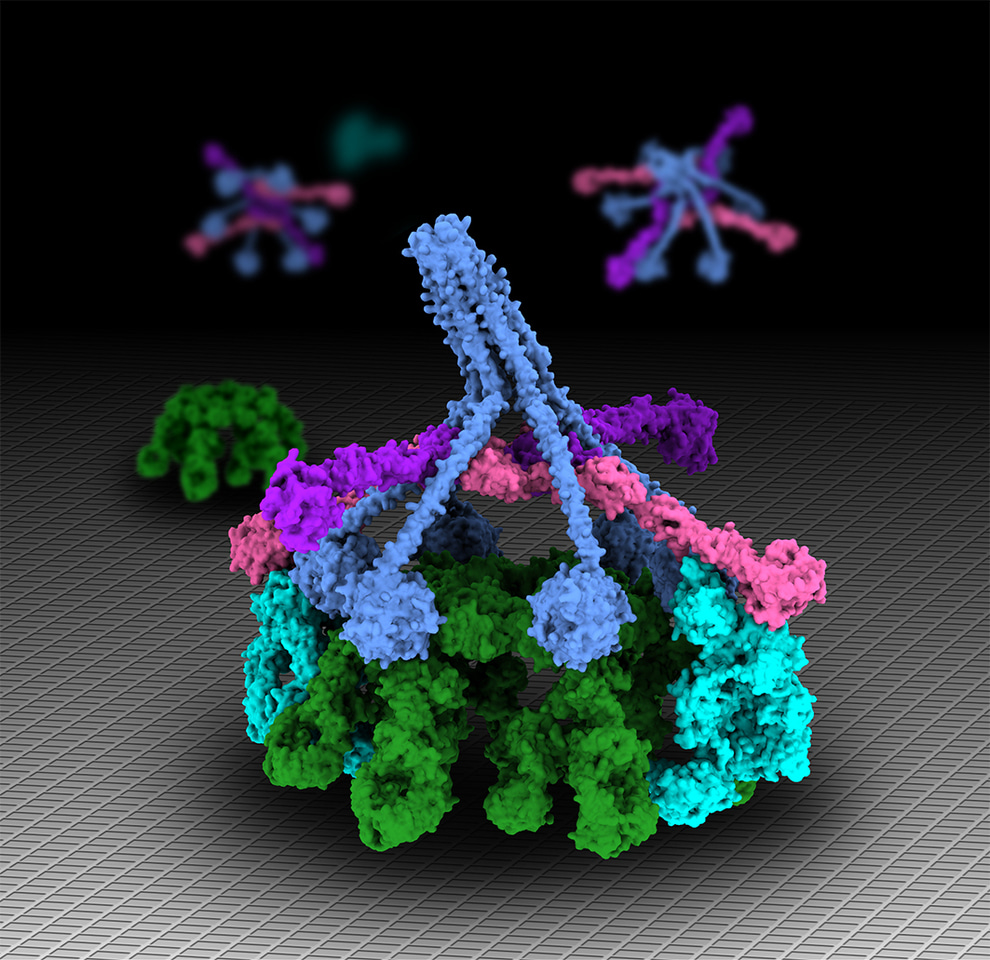
Microbial complement evasion and vaccine development
Seppo Meri and Hanna Jarva 
Complement as part of both the innate and adaptive immune systems plays a
central role in our defense against infections. Although its antimicrobial effects have been known for well over 100 years, its significance for boosting our immunity against pathogens has been relatively neglected. It has become apparent only recently that one of the major characteristics of a pathogenic microbe is that it can escape complement attack. All viruses, many bacteria, and certain life forms of fungi and protozoan parasites can hide inside cells, where they are protected from antibodies, complement, and other humoral immune effector mechanisms. Most microbes, however, have extracellular forms, although some of them are not capable of multiplying without the replicative machinery of the host, such as viruses, or the protective intracellular environment.
This Special Issue of FEBS Letters contains 14 articles devoted to the role of complement in microbial infections and is particularly timely because the SARS‐CoV‐2 pandemic has dramatically increased the public interest in microbes and in preventing infections. Below, we will briefly summarize the role of complement in viral and bacterial infections as described in the individual articles belonging to this collection. In addition, the role of complement in the complex infections caused by Aspergillus fungi and Plasmodium falciparum parasites is discussed in their separate articles by Parente et al. [[1]] and Kiyuka et al. [[2]], respectively.
Aspergillus fungi are opportunistic pathogens, yet they can cause multiple types of infections, especially in patients receiving immunosuppressive drugs or suffering from immune deficiency. In immunocompromised individuals, complement, however, is still active but apparently, Aspergillus can escape it and cause an invasive infection. Aspergillusfungi can cause both infectious and allergic lung disease and a tumor‐type aspergilloma. There are different forms of the fungi that interact with the complement system and pentraxins, like C‐reactive protein and PTX‐3. Pentraxins closely co‐operate with the complement system by both activating and regulating it. In a thorough article, Parente et al. [[1]] explain how Aspergillus can cope with these two protein systems.
The causative agents of malaria, and especially its most dangerous species, P. falciparum, are another group of complex organisms with different life forms. Kiyuka et al. [[2]] will give you an update on what is currently known about complement evasion by plasmodia, and how this information could be used for preparing efficient, functional vaccines.
As a medical problem, complement resistance is comparable to antimicrobial resistance (AMR). AMR is a ‘man‐made’ problem that has mostly emerged only during the last 100 years, when antibiotics have been adopted for treating infections in humans and animals. In contrast, the resistance to complement has developed during a very long time in evolution. The emergence of complement‐resistant pathogenic microbes has occurred simultaneously with the development of the complement system in different animals. Complement resistance in microbes has contributed to the creation of the repertoire of pathogenic microbes. AMR poses a threat because we will be losing the most commonly used tools against microbial infections caused by pathogenic and/or opportunistic microbes. The fact that opportunistic microbes, like Acinetobacter, Enterobacter sp., Klebsiella, and Pseudomonas, can cause infections depends usually on a decreased local or generalized immune activity of the host. Then, even if the microbe would be sensitive to complement, it could cause an infection. Real pathogens, however, can survive complement attack in the niches, where they cause infections.
Why is it important to study complement evasion mechanisms of microbes? Complement resistance is an important virulence mechanism of many pathogenic microbes. As with other virulence mechanisms (e.g., adhesion, production of toxins), it is important to know which factors are responsible for the ability of a microbe to avoid complement‐mediated opsonophagocytosis or direct killing. This will be helpful for the development of vaccines, passive antibody therapy, or possible new types of antimicrobials to counteract the resistance mechanism. Learning how microbes or other organisms (like ticks or insects feeding on blood) can inhibit complement could also advise us to develop new therapeutics to suppress overactivity of complement that occurs in many human diseases. Understanding how microbes deal with the complement system helps us also to understand the fundamental mechanisms of the system itself and relative contributions of its individual pathways and components.
From the microbial perspective, complement resistance is important for the ability to survive and multiply in animal hosts. Naturally, many other factors are needed, as well. Microbes need to have the right types of ligands for host receptors and other molecules for attachment and invasion into cells and tissues. Often, they need toxins to provide enough debris for growth and provision of nutrients. In extreme cases, the toxins and infections themselves can be detrimental to the host. The medical impact of microbial infections is enormous and now increasingly appreciated by the current SARS‐CoV‐2 pandemic. While interactions of the SARS‐CoV‐2 with complement are still under study, our current Special Issue of FEBS Letters will provide a panoramic view of what is currently known of interactions between various microbes and the complement system. This will be instructive for studies on other microbes, including the coronaviruses and for any other potential infection threats in the future.
The complement resistance of viruses is discussed thoroughly by Agrawal et al. [[3]]. While pathogenic bacteria are experts in stealing and exploiting host proteins, virulent viruses usually have stolen host genes and modified them for their own purposes. As elegantly indicated in this review, viruses as pathogenic as, for example, the poxviruses mimic complement‐regulating proteins of their hosts. In humans, the regulators usually are composed of major structural units, complement control protein repeats encoded in chromosome 1 in the so‐called regulators of complement activation (RCA) gene cluster. In addition, a mimic for the membrane attack complex inhibitor CD59 can be found in the monkey herpesvirus H. saimiri.
Because of the increasing emergence of problems caused by viruses, it is obvious that we need to learn more about their complement escape mechanisms. Dengue viruses belong to a larger group of flaviviruses that cause different types of infections (West Nile virus, yellow fever virus, and Zika virus). As explained by Carr et al. [[4]], complement can have multiple roles in the mosquito‐borne dengue virus infections. In some situations, antibody‐mediated immunity and complement can be protective, but on some other occasions, they can severely promote the inflammatory response and lead to a severe complication, the capillary leak syndrome. The fact that viruses have developed multiple functional interactions with complement factors provides a solid and unbiased proof for the importance of complement as an immune defense mechanism.
This issue showcases eight reviews on the interactions of complement with various bacteria. Staphylococci are masters of immune evasion, as illustrated in the article by de Vor et al. [[5]]. They can block complement at many steps, galvanize neutrophils, and form biofilms for their protection (e.g., in wound infections and on implants). In this review, the reader can have a look at the largest repertoire of complement‐inhibiting factors known for any bacterium and mechanisms of biofilm generation. Interestingly, the latter show differences between S. epidermidis and S. aureus, common causes of infections both on surfaces and deep inside tissues.
Streptococcus pneumoniae (pneumococcus) causes bacterial upper respiratory tract infections, pneumonia, sinusitis, and otitis. It can also cause meningitis and septic infections. Pneumococci and other streptococci are discussed by Syed et al. [[6]]. Like other pathogens, group A streptococci (S. pyogenes) and pneumococci exploit soluble complement inhibitors, particularly factor H for complement escape. For this, they use specific surface proteins, most commonly the M protein or the PspC family proteins. Other important virulence factors are cytolysins, streptolysin and pneumolysin, that generate pores on cells somewhat similarly as the complement membrane attack complex (MAC). The respiratory pathogens Haemophilus influenzae and Moraxella catarrhalis, as elegantly presented by Riesbeck [[7]], also exploit the soluble complement inhibitors, C4bp and factor H, for their protection. In addition, both have been found to bind vitronectin, which may help in preventing bactericidal complement lysis of these Gram‐negative bacteria. The bacteria use multiple types of surface molecules for complement escape and for adhesion to host cells.
The Gram‐negative bacteria Salmonella and Yersinia can cause both enteric and systemic infections. Krukonis and Thomson [[8]] describe strategies underlying their ability to cause systemic infections and invade deep into tissues. These properties are to a large extent based on their ability to hijack complement inhibitors, interfere with MAC formation, and proteolytically destroy complement proteins. As explained, different components of the bacteria contribute to these functions.
Bacterial sepsis is an emergency in the medical care. It can be caused by many bacteria, notably by staphylococci, pneumococci, meningococci, or Gram‐negative enteric bacteria. This is a situation where complement activation and other inflammatory mechanisms have turned into our enemies. Efforts have been made to search for means to inhibit this overwhelming inflammatory condition. Mollnes and Huber‐Lang [[9]] provide us an update on ongoing attempts to use state‐of‐the‐art complement inhibitors and Toll‐like receptor blockers to save patients.
Spirochetes constitute a peculiar group of bacteria with distinct characteristics. Barbosa et al. [[10]] present us Leptospira sp., a large group that includes both pathogens and nonpathogens. This has made it possible to perform a meaningful comparison of their ability to resist killing by complement, for example, in human serum. Not surprisingly, yet importantly, these studies have shown that the complement‐resistant Leptospira sp. are also the pathogenic ones. They can bind complement inhibitors from the host and exploit their own and host proteases for their benefit. Leptospires are important zoonotic disease pathogens in the tropics, especially under low hygienic conditions. In contrast, in the Northern Hemisphere, both in Europe and in North America, spirochetes of the Borrelia genus cause borreliosis, also called Lyme disease. Dulipati et al. [[11]] provide an account of their mechanisms of complement evasion, describing particularly the various spirochetal proteins that mediate factor H binding or use other means of complement escape. Borrelia spirochetes are spread by ticks and can cause insidious infections with different clinical manifestations. No vaccines exist against borreliosis, but this disease is one where complement regulator‐binding proteins could be considered as candidates. This thinking is based on the potential dual benefit of their use: Indeed, antibodies generated against the factor H‐binding proteins would target the immune response against the bacteria and also neutralize an important virulence mechanism on borrelia surface, thereby sensitizing the bacteria to complement killing.
The relevance of the complement for the rational design of vaccines is also covered by two reviews in this Special Issue, and here, we discuss how the lessons learned from these studies may apply to SARS‐CoV‐2 management. In 2008, we wrote an article about considering microbial inhibitors as vaccines [[12]]. To our great satisfaction, this has now become reality, because two novel vaccines against group B meningococcus based on complement factor H‐binding proteins are available on the market [[13]]. The novel concept was to realize that, for an efficient vaccine‐induced immune response, it is important to understand the key virulence mechanisms of the disease‐causing pathogen. In the case of group B meningococcus, this meant that the ability of the bacterium to escape complement would be neutralized by the vaccine‐induced immune response. This may occur during normal development of immunity that follows an infection. As described by Lewis and Ram [[14]], both Neisseria meningitidis and N. gonorrhoeae are specific human pathogens. This specificity is principally due to the fact that these two bacteria bind human inhibitors of complement factor H‐ and C4b‐binding protein (C4bp), respectively. This strongly advocates the importance of complement evasion as a key factor determining the pathogenicity of the microbes. Since the mortality for meningococcal infections, meningitis and sepsis, is very high, we cannot rely on naturally developing immunity but need to intervene efficiently and as fast as possible by antibiotics in acute infections. In areas with higher risk of infections, vaccines provide a safer means of prevention.
Similar key questions concern now also SARS‐CoV‐2: Is the risk of having an infection and its potential serious consequences high enough to warrant wide‐scale vaccination? Without major doubt, the answer to this question is yes. Experience has shown that the key means for future protection against the coronavirus infection will be vaccination and vaccines are intensively under development. But do they consider sufficiently the virulence mechanisms of the virus? And do we know enough of the virulence mechanisms, particularly about the immune escape mechanisms? What is it that makes the virus so pathogenic? How does it escape complement‐mediated neutralization or opsonophagocytosis? Could antibodies, naturally developing or vaccine‐induced, even enhance infectivity of the virus? We are not even fully sure yet whether protective immunity develops, and particularly, for how long does it last.
Another important point that we raised about vaccination was that if proteins included in vaccines strongly bind host proteins, then they may lose part of their ability to raise a proper immune response [[12]]. Many pathogens escape complement attack by binding the soluble complement inhibitor factor H, a strategy that also the human body uses to distinguish self from nonself [[15]]. Thus, it is natural to have microbial factor H‐binding proteins (FHBP) in vaccines, as is the case in group B meningococcal vaccines [[13]]. If vaccines contain proteins that bind too strongly to host factor H, they may be scavenged away from reaching antigen‐capturing dendritic cells. Also, since factor H is an inhibitor of complement, factor H binding to the vaccine component could limit the efficacy of the vaccine by preventing the natural adjuvant effect that complement has. Activation products of especially the complement component C3 (C3b, iC3b, C3dg, and C3d) remain covalently bound to target antigens that activate complement. They are important for the uptake of the antigens by antigen‐presenting cells (dendritic cells, macrophages, and B cells) via the complement receptors CR1 (CD35), CR2 (CD21), and CR3 (CD11b,18). Complement receptors and their utilization by microbes are discussed in this issue by Lukácsi et al. [[16]]. While these receptors serve an important function in the phagocytosis of microbes, they can also be misused for microbial entry into host cells.
If vaccine antigens form complexes with host proteins, autoimmunity could arise in the worst case. For this to happen, the FHBP‐factor H complexes should be taken up by factor H‐reactive B cells. With the help provided by the microbial protein reactive CD4+ helper T cells, these B cells could become activated and start generating autoantibodies against factor H. It is known that autoantibodies against factor H occur in and cause one type of atypical hemolytic uremic syndrome (aHUS) [[17]]. The origin of these antibodies is not known, but could involve a preceding microbial infection. A means to avoid loss of efficiency of vaccination as well as the risk for autoimmunization could be to modify the vaccine antigens so that they maintain immunogenicity but do not bind so effectively to host proteins [[12]]. Animal experiments have, indeed, shown that stronger immune responses can be achieved by vaccine FHBP antigens that have been modified to disable factor H binding [[18]].
As with other pathogens, it is apparent that the SARS‐CoV‐2 virus needs to escape complement attack. However, so far the mechanisms are not yet known. Since the complement system is one of the major effector mechanisms of immune responses, it would be important to delineate how future vaccines could induce an appropriate and sufficiently strong response to neutralize the SARS‐CoV‐2 virus. In essence, such a response should be able to block the key virulence factors and mechanisms of the virus. Prevention of virus binding to its receptors by vaccine‐induced antibodies is important but not sufficient. In fact, the antibodies raised by the vaccine should also activate the complement system in order to promote opsonophagocytosis and direct neutralization of the virus. Complement activation is also important for triggering a cell‐mediated immune response, because C3 activation products covalently linked to viral antigens mediate pathogen uptake and delivery for presentation to T cells in the secondary immune tissues. While an efficient protective immune response is needed, the other key aspect is the safety of the vaccine. With a focused and carefully targeted, functional vaccine approach, the potential side effects become less likely.
To conclude, we hope that individual articles in this Special Issue will provide a view to the most relevant interactions between complement and various microbes. The general feeling and understanding in the field, as reflected by the articles, is that this area of research is important for the development of vaccines and potential other therapeutic means to combat serious infections. Understanding the fundamentals of microbial virulence in general, and of complement resistance specifically, will be instructive for designing preventive tools and vaccines to new emerging pathogens.
Access the full Special Issue on Microbes and Complement
Biographies
 Seppo Meri, MD, PhD Seppo Meri is Professor of Immunology at the Medical Faculty, University of Helsinki, Finland, and the Chief Physician of Research in Microbiology at HUSLAB, Laboratory of the Helsinki University Hospital. He is also a visiting professor at the Humanitas University, Milan, Italy. His medical specialty is in Clinical Microbiology. He served as a postdoctoral fellow at the University of Texas in 1988 and in 1989–90 as an EMBO fellow at MRC, Cambridge, UK. His research interests include diseases related to disturbances in complement regulation and reasons for increased susceptibility to microbial infections. He has published ≈ 270 original research articles and 130 reviews or textbook chapters on complement, autoimmunity, and microbial escape. He has been the President of the Scandinavian Society for Immunology 2001‐2007 and of the European Complement Network 2001‐2003. He served as the Secretary‐General of the International Union of Immunological Societies 2010‐2016 and as a member of the FEBS Publication Committee 2014‐2018. He is a Member of the Finnish National Academy of Sciences since 2009.
Seppo Meri, MD, PhD Seppo Meri is Professor of Immunology at the Medical Faculty, University of Helsinki, Finland, and the Chief Physician of Research in Microbiology at HUSLAB, Laboratory of the Helsinki University Hospital. He is also a visiting professor at the Humanitas University, Milan, Italy. His medical specialty is in Clinical Microbiology. He served as a postdoctoral fellow at the University of Texas in 1988 and in 1989–90 as an EMBO fellow at MRC, Cambridge, UK. His research interests include diseases related to disturbances in complement regulation and reasons for increased susceptibility to microbial infections. He has published ≈ 270 original research articles and 130 reviews or textbook chapters on complement, autoimmunity, and microbial escape. He has been the President of the Scandinavian Society for Immunology 2001‐2007 and of the European Complement Network 2001‐2003. He served as the Secretary‐General of the International Union of Immunological Societies 2010‐2016 and as a member of the FEBS Publication Committee 2014‐2018. He is a Member of the Finnish National Academy of Sciences since 2009.

Hanna Jarva, MD, PhD Hanna Jarva is Adjunct Professor of Immunology at the Department of Bacteriology and Immunology, Haartman Institute, University of Helsinki, and Chief Physician at the Department of Virology and Immunology, HUS Diagnostic Center, HUSLAB, Clinical Microbiology. She is also head of research and education at HUSLAB Clinical Microbiology. Dr Jarva’s research activities concentrate on different aspects of the complement system but her main focus has been the complement evasion mechanisms of bacteria. Hanna Jarva is also active in the Scandinavian Society for Immunology, where she serves as a board member and treasurer.
References
1. , , , and (2020) The complement system in Aspergillus fumigatus infections and its crosstalk with pentraxins. FEBS Lett 594, 2480– 2501.
2. , and (2020) Complement in malaria: immune evasion strategies and role in protective immunity. FEBS Lett 594, 2502– 2517.
3. 3, , , , and (2020) The imitation game: a viral strategy to subvert the complement system. FEBS Lett 594, 2518– 2542.
4. , , , and (2020) Dengue virus and the complement alternative pathway. FEBS Lett 594, 2543– 2555.
5. , and (2020) Staphylococci evade the innate immune response by disarming neutrophils and forming biofilms. FEBS Lett 594, 2556– 2569.
6. , , , and (2020) Streptococci and the complement system: interplay during infection, inflammation and autoimmunity. FEBS Lett 594, 2570– 2585.
7. (2020) Complement evasion by the human respiratory tract pathogens Haemophilus influenzae and Moraxella catarrhalis. FEBS Lett 594, 2586– 2597.
8. and (2020) Complement evasion mechanisms of the systemic pathogens Yersiniae and Salmonellae. FEBS Lett 594, 2598– 2620.
9. and (2020) Complement in sepsis – when science meets clinics. FEBS Lett 594, 2621– 2632.
10. and (2020) Strategies used by Leptospira spirochetes to evade the host complement system. FEBS Lett 594, 2633– 2644.
11. , and (2020) Complement evasion strategies of Borrelia burgdorferisensu lato. FEBS Lett 594, 2645– 2656.
12. , and (2008) Microbial complement inhibitors as vaccines. Vaccine 26(Suppl 8), I113– I117.
13. , and (2020) Meningococcal factor H binding protein as immune evasion factor and vaccine antigen. FEBS Lett 594, 2657– 2669.
14. and (2020) Complement interactions with the pathogenic Neisseriae: clinical features, deficiency states, and evasion mechanisms. FEBS Lett 594, 2670– 2694.
15. (2016) Self‐nonself discrimination by the complement system. FEBS Lett 590, 2418– 2434.
16. , , , , , and (2020) Utilization of complement receptors in immune cell‐microbe interaction. FEBS Lett 594, 2695– 2713.
17. , , , , , , , and (2005) Anti‐Factor H autoantibodies associated with atypical hemolytic uremic syndrome. J Am Soc Nephrol 16, 555– 563.
18. , , , , and (2016) Enhanced protective antibody to a mutant meningococcal factor H‐binding protein with low‐factor H binding. JCI Insight 1, e88907.
First published in FEBS Letters, Issue 594, 23 August 2020. doi:10.1002/1873-3468.13892
How to cite this article: Meri, S. and Jarva, H. (2020), Microbial complement evasion and vaccine development. FEBS Lett, 594: 2475-2479. https://doi.org/10.1002/1873-3468.13892





Join the FEBS Network today
Joining the FEBS Network’s molecular life sciences community enables you to access special content on the site, present your profile, 'follow' contributors, 'comment' on and 'like' content, post your own content, and set up a tailored email digest for updates.